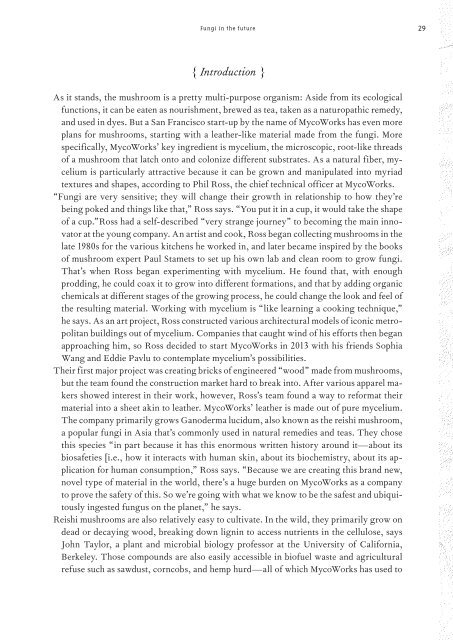Logbuch_17x24Druck_einzelseiten
Create successful ePaper yourself
Turn your PDF publications into a flip-book with our unique Google optimized e-Paper software.
Fungi in the future<br />
29<br />
{ Introduction }<br />
As it stands, the mushroom is a pretty multi-purpose organism: Aside from its ecological<br />
functions, it can be eaten as nourishment, brewed as tea, taken as a naturopathic remedy,<br />
and used in dyes. But a San Francisco start-up by the name of MycoWorks has even more<br />
plans for mushrooms, starting with a leather-like material made from the fungi. More<br />
specifically, MycoWorks’ key ingredient is mycelium, the microscopic, root-like threads<br />
of a mushroom that latch onto and colonize different substrates. As a natural fiber, mycelium<br />
is particularly attractive because it can be grown and manipulated into myriad<br />
textures and shapes, according to Phil Ross, the chief technical officer at MycoWorks.<br />
“Fungi are very sensitive; they will change their growth in relationship to how they’re<br />
being poked and things like that,” Ross says. “You put it in a cup, it would take the shape<br />
of a cup.”Ross had a self-described “very strange journey” to becoming the main innovator<br />
at the young company. An artist and cook, Ross began collecting mushrooms in the<br />
late 1980s for the various kitchens he worked in, and later became inspired by the books<br />
of mushroom expert Paul Stamets to set up his own lab and clean room to grow fungi.<br />
That’s when Ross began experimenting with mycelium. He found that, with enough<br />
prodding, he could coax it to grow into different formations, and that by adding organic<br />
chemicals at different stages of the growing process, he could change the look and feel of<br />
the resulting material. Working with mycelium is “like learning a cooking technique,”<br />
he says. As an art project, Ross constructed various architectural models of iconic metropolitan<br />
buildings out of mycelium. Companies that caught wind of his efforts then began<br />
approaching him, so Ross decided to start MycoWorks in 2013 with his friends Sophia<br />
Wang and Eddie Pavlu to contemplate mycelium’s possibilities.<br />
Their first major project was creating bricks of engineered “wood” made from mushrooms,<br />
but the team found the construction market hard to break into. After various apparel makers<br />
showed interest in their work, however, Ross’s team found a way to reformat their<br />
material into a sheet akin to leather. MycoWorks’ leather is made out of pure mycelium.<br />
The company primarily grows Ganoderma lucidum, also known as the reishi mushroom,<br />
a popular fungi in Asia that’s commonly used in natural remedies and teas. They chose<br />
this species “in part because it has this enormous written history around it—about its<br />
biosafeties [i.e., how it interacts with human skin, about its biochemistry, about its application<br />
for human consumption,” Ross says. “Because we are creating this brand new,<br />
novel type of material in the world, there’s a huge burden on MycoWorks as a company<br />
to prove the safety of this. So we’re going with what we know to be the safest and ubiquitously<br />
ingested fungus on the planet,” he says.<br />
Reishi mushrooms are also relatively easy to cultivate. In the wild, they primarily grow on<br />
dead or decaying wood, breaking down lignin to access nutrients in the cellulose, says<br />
John Taylor, a plant and microbial biology professor at the University of California,<br />
Berkeley. Those compounds are also easily accessible in biofuel waste and agricultural<br />
refuse such as sawdust, corncobs, and hemp hurd—all of which MycoWorks has used to


